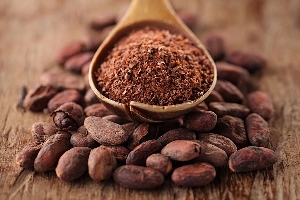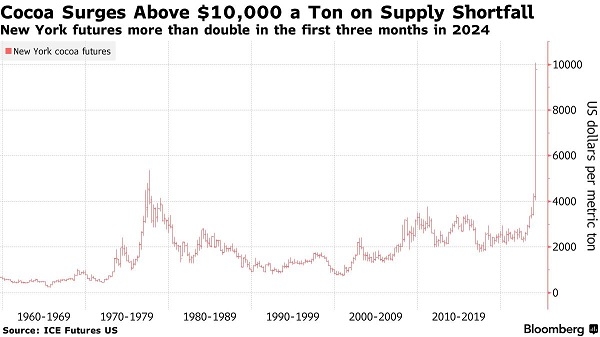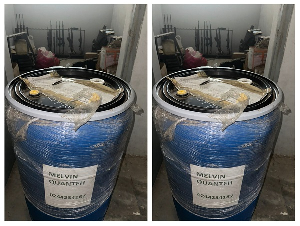 Cocoa is a key export commodity for Ghana
Cocoa is a key export commodity for Ghana
After a steady rise over two years, the price of cocoa beans skyrocketed this year, with futures contracts more than doubling in three months to reach a level in March twice as high as the previous record. It’s a progression that has its literal roots in small West African farms but also involves climate change and the intricacies of the futures market.
The latest surge has been driven in part by the kind of financial turmoil that can happen when commodities rise so fast that they overwhelm strategies meant to protect against such volatility.
The upshot is almost certainly bound to be more expensive chocolate that may come in smaller servings. But even if prices recede from current levels, they’re likely to remain elevated for years to come. Economists like to say that the cure for high prices is high prices, since they can reduce demand, spur increases in supply, or both.
But the situation with cocoa shows how messy that idea can be in practice, given market complexities and obdurate physical facts like how long it takes for a new cocoa tree to grow.
Where we’re at
Cocoa futures in New York and London are pricier than they ever have been in nominal dollars, surging past the highs seen in 1977 when the world was facing another cocoa shortage. Futures contracts traded in New York hit an intraday record of $10,080 a metric ton on March 26 and have since been trading above $9,500, while London beans traded above £8,000 a ton (about $10,000). Before this rally, New York futures had largely remained below $3,500 since the 1980s.
A record supply crunch has driven the surge, with the world on track for a third year of deficits. Production is expected to fall short of demand in 2024 by 374,000 tons, according to the International Cocoa Organization, while manufacturer Barry Callebaut expects a gap of about 500,000 tons, equal to about a 10th of the global market.

How we got here
Unlike most crops grown for global commodity markets, cocoa is produced not by large scale plantations but by small farmers, many in West Africa, which has dominated the trade for decades. Ivory Coast and Ghana are still forecast to supply 53% of the world’s cocoa in the current season — a share that was even higher before current crop issues. Here are some of the factors that have been driving down production:
Both rain and drought have been more severe than usual in West Africa
Swamped fields have worsened the spread of diseases like black pod disease and swollen-shoot virus, which are rotting pods and killing trees, and the tree stock is also aging
The small farmers in Ivory Coast and Ghana have long been underpaid; since governments set prices in each country before each new growing season, producers have yet to profit from the current rally
Low pay has hampered farmers’ ability to invest in improvements and fend off disease, limiting how much cocoa their trees can yield
What else is driving the price spike
The record cocoa shortage produced by those factors can account for the generally higher trend in prices, and Citi Research analysts had pointed last month
to a trading range between $7,000 to $10,000 a ton. But the magnitude of the latest surge — which saw New York cocoa futures rise more than $1,000 during two sessions — has led market watchers to believe financial drivers are also at play.

That’s because traders usually use the futures market to hedge risk in the physical market. Sellers who have cocoa on hand hope that prices go up but will protect themselves by making side bets on falling prices. If prices go up, their gains on their stockpiles more than cover what they paid for those so-called short positions. But if prices go down and their stockpiles are worth less, their short bets will offset some of their losses.
That kind of hedging works well when commodities move both up and down and within a moderate range. What gets complicated by sharp one-way market moves is the requirement that traders post collateral to cover their futures bets. If prices only go up, and go up sharply enough, the cost of adding to that collateral may become unaffordable. That can lead some traders to close out their positions — which can only be done by buying more cocoa contracts, which further drives up prices.
The Intercontinental Exchange has also taken steps to keep markets orderly, like reducing the amount of cocoa that traders can buy through the London exchange. The so-called delivery limit is going from 75,000 tons in May to 50,000 tons in July, and down progressively until it reaches 25,000 tons for the December contract onward.
What this means for consumers
Chocolatiers are doing all they can to offset higher costs — hiking retail prices, shrinking pack sizes, maximizing efficiency and pushing products with less cocoa. But those shifts are just the beginning: Companies hedge prices and secure supplies well in advance, so the impact of the new, record-high futures hasn’t fully trickled down to retail shelves yet. Chocolate makers are likely to see that inflation over six to 12 months, and then consumers will face it too, according to Bloomberg Intelligence.
The pinch will also be felt by chocolate processors and their workers. Plants in Ghana have been closed intermittently because of supply shortages. Major cocoa processors Barry Callebaut AG and Blommer Chocolate Co. have also said they would be shutting down facilities and laying off employees
Who’s winning, who’s losing
Higher prices are good in the long run for farmers, who have long been underpaid. But so far, growers in the world’s biggest-producing countries are also the ones missing out on the rally’s full profits. That’s because Ivory Coast and Ghana’s governments set cocoa prices based on sales made a year earlier.
Farmers in Ivory Coast are receiving 1,000 CFA francs per kilogram, while those in Ghana are getting 20,928 cedis a ton – both equating to about $1,600 per ton. Producers in Ivory Coast are pushing for more pay for the mid-crop harvest starting in April, but the country’s industry regulator has proposed keeping prices the same, Bloomberg reported.
Meanwhile, farmers in liberalized markets like in Brazil, Ecuador, Cameroon and Nigeria are ramping up production to take advantage of higher prices. Brazil and Cameroon are trying to double output by the end of the decade, while Ecuador is targeting 800,000 tons of output
by 2030 — an amount that could allow the nation to overtake Ghana to become the world’s second-largest producer, behind only Ivory Coast. But trees take time to grow, so it will be at least three years before new pods provide supply relief. European Union rules preventing the trade of products linked to deforestation could also limit acreage expansion for cocoa and crunch supplies in the world’s biggest chocolate-consuming region.
The longer term prospects
Supply isn’t likely to make a rapid recovery. The smaller mid-crop harvest in Ivory Coast that is just kicking off is expected to be weaker than last year, and some are already bracing for another deficit next season.
On the other side of the equation, expensive chocolate is already weighing on demand, prompting consumers to pick up less of it. Favorable weather could facilitate a quicker recovery in production. Governments in Ivory Coast and Ghana could also increase the amount paid to farmers. That would fund reinvestments in pesticides, fertilizer and labor to boost 2025 crop yields. New producers in Latin America and elsewhere, lured by high prices, will also start contributing to global supply in the years to come.
- Man jailed 7 years for cocoa smuggling
- Cocoa prices decline by 10% as traders exiting market amplify price swings
- Another scientist testifies in GH¢271m COCOBOD financial loss case
- Ivory Coast seeks to avoid cocoa export defaults after price hike
- Who is paying $10,000 for cocoa? - CGCI asks global cocoa buyers
- Read all related articles












